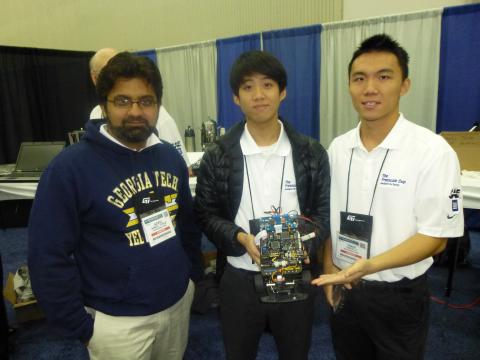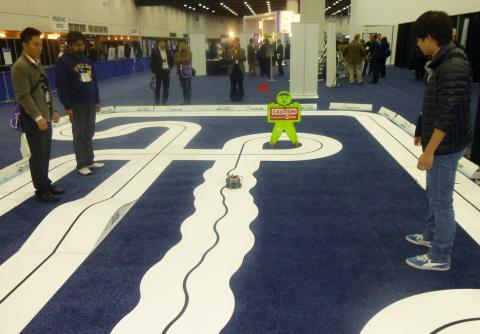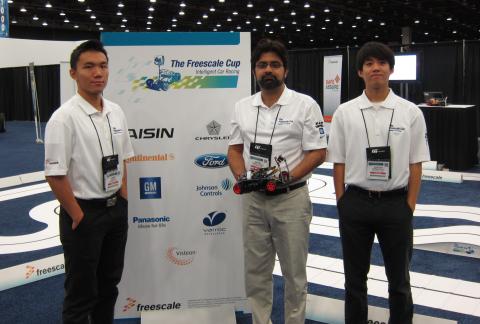The Panasonic/Georgia Tech team–known as PIC Jackets–took third place in the Freescale Cup autonomous vehicle race event at SAE Convergence, held at the Detroit Cobo Center in Detroit, Mich. on October 17.
The Panasonic/Georgia Tech team took third place in the Freescale Cup autonomous vehicle race event at SAE Convergence, held at the Detroit Cobo Center in Detroit, Mich. on October 17. (View video of the PIC Jackets in action and their final score in the competition.)
Known as PIC Jackets–short for Panasonic Innovation Center-Jackets, the team was made up of students from Tech’s School of Electrical and Computer Engineering (ECE), led by Fulbright scholar Adeel Yusuf, a computer engineering Ph.D. student who works with ECE Professor Vijay K. Madisetti. Joining Mr. Yusuf on the team were Jeffery Kuo, a senior computer engineering major, and Vince Li, a junior majoring in both computer engineering and mechanical engineering; both undergraduates are co-op students working at the Center this semester. The team was sponsored by Panasonic Automotive Systems of America (PASA) and mentored by Georgia Tech alumnus John Avery.
The SAE Convergence event featured 10 teams, including automotive original equipment manufacturers and Tier-1 suppliers, and was modeled after the Freescale Cup competition, which includes over 25,000 students, 9,500 teams, and 600 colleges and universities in 18 countries. The teams build, program, and race a model car around a track for speed, and the winning car is the one that completes the track in the fastest time without derailing.
This year, PIC Jackets was the only student team in the event, competing against professional engineers from the automotive industry and placing behind teams from Chrysler and Ford, respectively. Designing this autonomous car requires embedded software programming and basic circuit creation using Freescale parts included in the entry kit. Students then create motor control hardware and software to propel and steer their intelligent car, and they must also interface to a camera to navigate the car through the race course by following the guide line in the middle of the track.
The PIC Jackets began working on their car at the beginning of September and accelerated their efforts as the competition date drew closer. Mr. Kuo worked on coding and testing different mathematical concepts, including the final code, and Mr. Yusuf handled the mathematical modeling and optimization of the steering and speed of the car. Mr. Li was responsible for the test track and the mechanical aspects of the vehicle.
The team was not able to use the actual track until the day before the finals, so in practice runs the team innovated by sticking black tape over sheets of paper prior to the event. “Even after tireless efforts and careful mathematical calculations, we had to take the leap of faith to reach the podium,” said Mr. Yusuf. “As we were the only student team among the finalists, we are very proud of our finish in this competition.”
Additional Images


